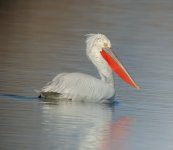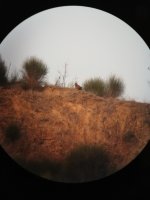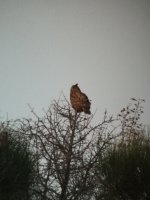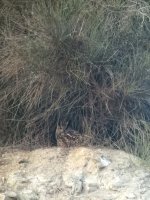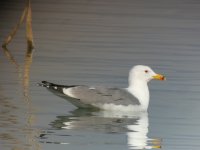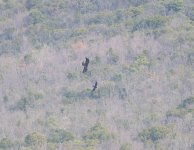dwatsonbirder
Well-known member
Introduction
The end of January 2024 saw me changing companies, and after five years of continuous employment, I decided to undertake a short trip between contracts. Initially I had grand aspirations of perhaps taking a month or so off and heading out to Asia, however with a mortgage to pay, and a wife who loves to travel, I had to settle for considerably more modest plans. Some friends had visited the Lake Kerkini area in 2022, and their enthusiasm for the area and its birds, along with the affordability and short travel time inspired me to follow in their footsteps.
Although there were few new species, feasible targets included one of my most wanted - Wallcreeper - along with the possibility of several south-eastern European species, and I was joined by my good friend Kieran for the first time for a while (and by John FT at the eleventh hour!), all of which was to hopefully make for an enjoyable short trip.
Logistics
We booked flights to Thessaloniki for £82 return from Gatwick, opting to take carry-on luggage only. An early morning flight meant getting a train across the previous evening and a night in the airport, however this meant that we were able to have an additional half days’ birding. We booked an SUV via Easyjet, with a discounted rate of £60 for five days' hire. We got a Dacia Duster (with some quite impressive dents already in situ) from Centauro. Car hire out of season is incredibly cheap, with a hatchback available for less than £8 per day. At under £300 per person all in, we were hopeful we had the makings of a cheap and fun trip with some winter sunshine and decent birding.
We used our mobiles for navigation, pre-loading various grid-reference locations into a group chat prior to the trip to ensure that we all had access to the information. In the past I’ve used maps.me and downloaded the respective tile for the area for offline navigation, that would likely also work well.
Our first night's accommodation was at Dimitra’s Home (via Booking.com), giving us an apartment a stone’s throw from Kalochori lagoon, and within striking distance of sites for Wallcreeper and Pine Bunting. Our main base at Kerkini was the Kerkini Aura apartments at Vyroneia, located on the north-east corner of the lake. Dimitra’s Home was a great base, offering a comfortable and modern place to stay, whilst the Aura apartments were more basic. We didn’t have much success with eating out, with the best options on the east side of the lake being in Irakleia.
Some gen was kindly provided by our friends Johny and Oli who had undertaken the trip in 2022, with additional information gleaned from various trip reports (mostly on Cloudbirders) and also via ebird. We had been warned that the weather was likely to be pretty cool, and as a result packed and dressed accordingly, though our appearance mirroring the michelin man at Gatwick on the Saturday evening must’ve been bemusing to some.
Targets
There were a number of new birds for each of us, varying to a degree on our exposure to European birding. We established the primary targets of the trip as Wallcreeper, Western Rock Nuthatch, Sombre Tit, Eagle Owl, Dalmatian Pelican and Pine Bunting, which would be new birds for all of us.
We also wanted to target some of the “classic” species on offer which would either be new birds for at least Kieran and/or John, or giving us the opportunity to increase our collective experience and exposure to some species which we don’t get to see regularly. These included Eastern Imperial and Greater Spotted Eagle, Great White Pelican, Smew, Red-Breasted and Lesser White-fronted Goose, Calandra Lark, Moustached Warbler, Long-eared Owl, Long-legged and Rough-legged Buzzard, as well as various winter plumaged waders and wildfowl. Other potentially interesting species in the area included Nutcracker (a serious bogey bird of mine), the potential future split of the lilfordi White-backed Woodpecker, Alpine Accentor, Rock Partridge and Pygmy Owl.
The end of January 2024 saw me changing companies, and after five years of continuous employment, I decided to undertake a short trip between contracts. Initially I had grand aspirations of perhaps taking a month or so off and heading out to Asia, however with a mortgage to pay, and a wife who loves to travel, I had to settle for considerably more modest plans. Some friends had visited the Lake Kerkini area in 2022, and their enthusiasm for the area and its birds, along with the affordability and short travel time inspired me to follow in their footsteps.
Although there were few new species, feasible targets included one of my most wanted - Wallcreeper - along with the possibility of several south-eastern European species, and I was joined by my good friend Kieran for the first time for a while (and by John FT at the eleventh hour!), all of which was to hopefully make for an enjoyable short trip.
Logistics
We booked flights to Thessaloniki for £82 return from Gatwick, opting to take carry-on luggage only. An early morning flight meant getting a train across the previous evening and a night in the airport, however this meant that we were able to have an additional half days’ birding. We booked an SUV via Easyjet, with a discounted rate of £60 for five days' hire. We got a Dacia Duster (with some quite impressive dents already in situ) from Centauro. Car hire out of season is incredibly cheap, with a hatchback available for less than £8 per day. At under £300 per person all in, we were hopeful we had the makings of a cheap and fun trip with some winter sunshine and decent birding.
We used our mobiles for navigation, pre-loading various grid-reference locations into a group chat prior to the trip to ensure that we all had access to the information. In the past I’ve used maps.me and downloaded the respective tile for the area for offline navigation, that would likely also work well.
Our first night's accommodation was at Dimitra’s Home (via Booking.com), giving us an apartment a stone’s throw from Kalochori lagoon, and within striking distance of sites for Wallcreeper and Pine Bunting. Our main base at Kerkini was the Kerkini Aura apartments at Vyroneia, located on the north-east corner of the lake. Dimitra’s Home was a great base, offering a comfortable and modern place to stay, whilst the Aura apartments were more basic. We didn’t have much success with eating out, with the best options on the east side of the lake being in Irakleia.
Some gen was kindly provided by our friends Johny and Oli who had undertaken the trip in 2022, with additional information gleaned from various trip reports (mostly on Cloudbirders) and also via ebird. We had been warned that the weather was likely to be pretty cool, and as a result packed and dressed accordingly, though our appearance mirroring the michelin man at Gatwick on the Saturday evening must’ve been bemusing to some.
Targets
There were a number of new birds for each of us, varying to a degree on our exposure to European birding. We established the primary targets of the trip as Wallcreeper, Western Rock Nuthatch, Sombre Tit, Eagle Owl, Dalmatian Pelican and Pine Bunting, which would be new birds for all of us.
We also wanted to target some of the “classic” species on offer which would either be new birds for at least Kieran and/or John, or giving us the opportunity to increase our collective experience and exposure to some species which we don’t get to see regularly. These included Eastern Imperial and Greater Spotted Eagle, Great White Pelican, Smew, Red-Breasted and Lesser White-fronted Goose, Calandra Lark, Moustached Warbler, Long-eared Owl, Long-legged and Rough-legged Buzzard, as well as various winter plumaged waders and wildfowl. Other potentially interesting species in the area included Nutcracker (a serious bogey bird of mine), the potential future split of the lilfordi White-backed Woodpecker, Alpine Accentor, Rock Partridge and Pygmy Owl.





